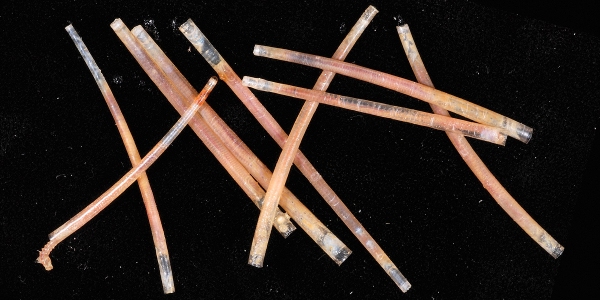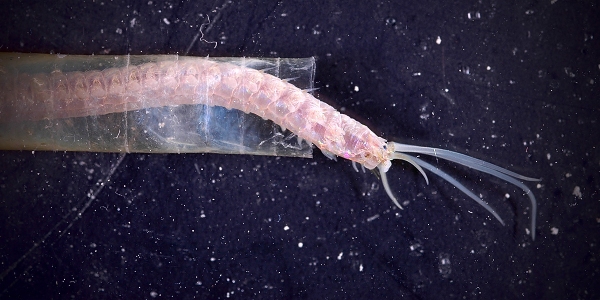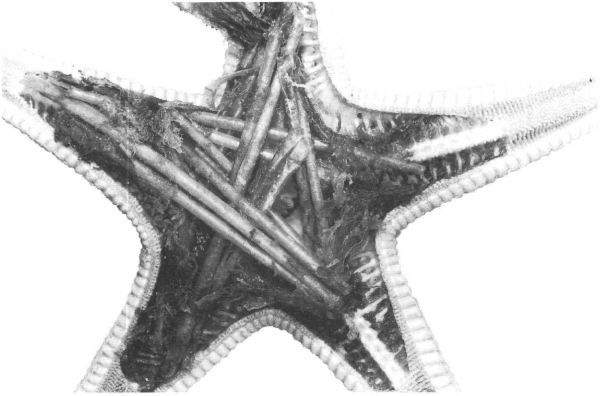"Quill - an instrument of torture yielded by a goose and commonly wielded by an ass" ~ Ambrose Pierce
Like a lot of mysterious underwater creatures of old, quill worms were named after their similarity to well known critters on land. In this case the "quill" is not part of a feather or an ancient writing device but rather a unique tube built by a polychaete worm that lives in it.
The two species known from the New Zealand region that secrete tubes of this classic quill-worm type are Hyalinoecia tubicola longibranchiata (Mclntosh,1885) and H. incubans (Orensanz, 1990). Hyaline means transparent or glassy. The NIWA invertebrate collection has more than 8000 quill-worms from 479 stations. Widely distributed and extremely common, they've been collected between 50-2800 metres deep but are typically found between 100-600m around the New Zealand continental shelf.
Multi-directional mobile homes
Hyalinoecia quill worms live on the surface of the sea floor and can move about using their bristly front legs to drag their tube home behind them much like a big rig truck hauling a very long container. On soft muddy sea floors they leave recognisable trails known as Lebensspuren ('life traces').
Up to 300 mm long, their semi transparent tubes have multiple protective flaps at each end. When "towing" and the tube gets stuck or snagged, the worm can double back inside the tube, open the back door and simply head off in the opposite direction. As it grows the quill worm also lengthens its tube and replaces the protective flaps front and back ensuring it can avoid sneaky predator attacks from the rear.
Watch this youTUBE clip by BlennyWatcher that shows how quill worms manoeuvre their heavy load home.
They build their light-weight, rigid tubes by secreting onuphic acid, the chemical composition of which has been of much interest to scientists due to it's unusual sugar-phosphate polymer structure—a unique substance to this group of animals.
Feed or be food
Quill worm heads have a three distinctive long antenna and a pair of "lips" below the antenna that are used to detect food smells, probe the seabed and forage for food. Hyalinoecia quill worms are highly active scavengers and can detect dead and dying animal prey falling to the sea bed from some distance. At times deepsea researchers have seen large aggregations of quill worms feeding and burrowing into dead fish carcasses.
In turn, New Zealand quill worms fall prey to predators like other polychaete worms, tarakihi and an astropectinid sea-star who eat them holus-bolus, tube and all!
NIWA scientists Geoff Read and Helen Clark found a number of greedy astropectinid starfish full of old quill worm tubes—so it appears that the onuphic tube material isn't particularly digestible or excretable. Remarkably the tubes eaten are as long as the total arm width of the starfish.
Kids stay home
Despite their widespread distribution, in New Zealand waters at least, Hyalinoecia quill worms form genetically distinctive populations: Challenger Plateau, the Hikurangi Margin, and the Chatham Rise areas. Some Hyalinoecia species incubate their eggs inside their tube until they hatch, so there isn't a long planktonic phase to their lifestyle. The larvae don't get picked up and dispersed by currents such as the Cook Strait current and are isolated by underwater barriers such as the shape and depth of seamount and shelf areas.
References
Read, Geoffrey B.; Clark, Helen E. S. 1999. Ingestion of quill-worms by the astropectinid sea-star Proserpinaster neozelanicus (Mortensen). New Zealand Journal of Zoology 26(1): 49-54]
Bors E.K., Rowden A.A., Maas E.W., Clark M.R., Shank T.M. 2012. Patterns of Deep-Sea Genetic Connectivity in the New Zealand Region: Implications for Management of Benthic Ecosystems. PLoS ONE 7(11): e49474. doi:10.1371/journal.pone.0049474
Graham G. N., P. G. Kelly, F. G. E. Pautard & R. Wilson 1965. Onuphic Acid—A Sugar Phosphate Polymer from the Tube of Hyalinoecia tubicola. Nature 206, 1256-1257 (1965) | doi:10.1038/2061256b0
Dayton, P.K., Hessler, R.R., 1972. Role of biological disturbance in maintaining diversity in the deep sea. Deep-Sea Research 19: 199–208.




